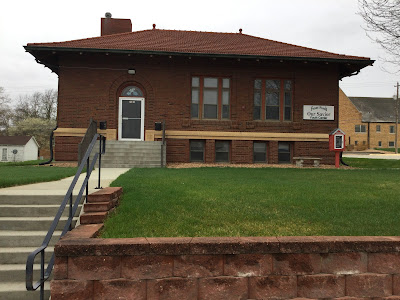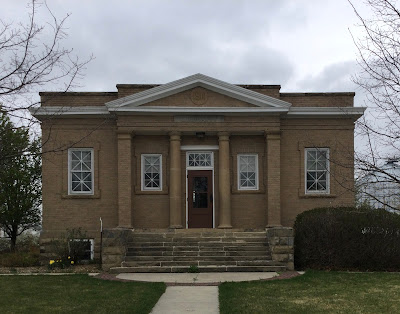
I’m in a region where small towns offer camping in their town park for a nominal fee or none at all. My preference is still finding a patch of trees off in the corn and wheat fields far from any habitation where I can imagine I’m having a night such as the early explorers enjoyed, even if it might require a couple of trips into a ravine carrying down my gear, then my bike, as was my happy lot several nights ago.

I did avail myself of the amenities of a town park a couple of nights ago when it began to drizzle just after I arrived at the Carnegie in Neligh in the early evening. I had hoped to ride for another hour and have another ninety mile day, but I didn’t care to settle into my tent dripping wet, especially since it was just thirty-eight degrees. No surprise, I had the campground all to myself. I was delighted to discover the park had WiFi along with electrical outlets galore so I could do some FaceTime with Janina as rain splattered on my tent. Her ever-attentive ears picked up the sound of chirping birds in the surrounding trees that had escaped my notice.
The Neligh Carnegie was another that was now someone’s home and had been for the past twenty years. It gave no hint that it was being lived in. I had to ask at the new library to learn what it had become.
It was my third Carnegie of the day, none of which still served as a library. The first in Wayne was now a youth center though it had a fully stocked Little Free Library out front. It had an off-center entrance, the first I can recall seeing of all the Carnegies I’ve visited. The new library was two blocks away and was attached to a senior center. Centers for seniors are a common feature of Nebraska towns. It was packed with people on couches in front of a television and three others in the background working on a puzzle.
The Carnegie in Pierce was being kept alive as a venue for special events—weddings and anniversary parties and such. It had most assuredly hosted many a memorable evening in its noble magnificence. Anyone in town would be happy for the opportunity to mount its stately steps knowing what splendor awaited them inside. I hear quite often from folks in towns whose Carnegies no longer serve as libraries that they have many fond memories of growing up with their Carnegie. They would gladly seize upon the opportunity to slip back into its warm confines.
I thought I was going to have my third consecutive three-Carnegie day the following day except the Carnegie in Randolph was no more. It was torn down in 2007, contrary to Wikipedia, which stated it had merely been replaced. So twelve, rather than eleven, of Nebraska’s sixty-nine Carnegies have been razed. Wikipedia color codes the libraries with green still a library, yellow something else and purple razed. Randolph was coded as yellow. The new library had been built on the site of its predecessor. It offered two small photographs of the Carnegie, one with one of its early librarians standing on its steps.
The Carnegie in Plainview was now a historical society and was another with the somewhat jarring off-center entrance. It may aid in making its inside space more usable, but it lessens the appeal of its outside appearance, unless it is a feature that one must become accustomed to since it is so uncommon among Carnegie libraries. Its lamp fixture was anything but ordinary. It was as if the contractor for the building had some money left over and spent it on the most grandiose lamp fixture available. White globed lamps are a common feature of Carnegies and vary considerably, though even the most subtle lend an extra measure of dignity to the buildings.Hartington offered me the first Carnegie in two days that still functioned as a library, though one could not enter through its original entrance but rather through the large addition to its side. And it was the third of the thirteen I have visited so far in Nebraska with its entrance to the left side of the building and not in the middle, evidently all by the same architect though the buildings do have some variation.
A plaque across the street in front of the courthouse stated that Lewis and Clark passed nearby in 1804 and held a four-day summit with the Sioux Indians. Another plaque in front of the Historical Museum stated that two of Nebraska’s governors had been born in Hartington.









No comments:
Post a Comment